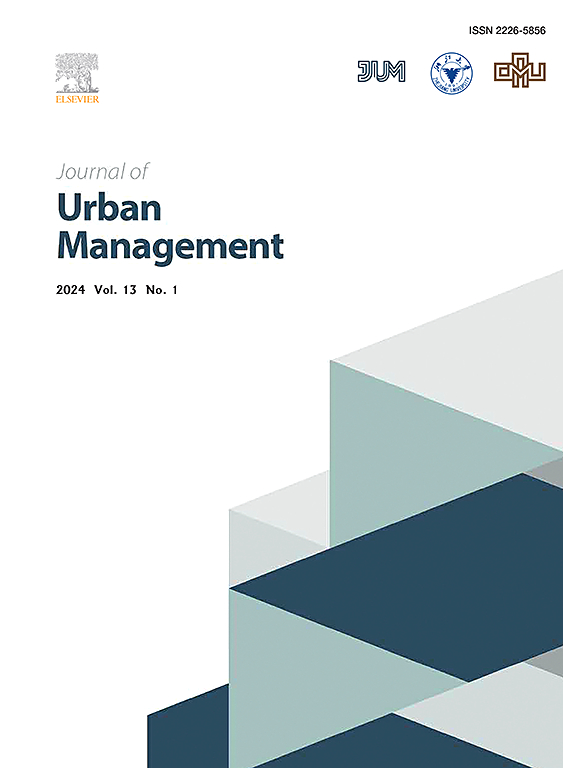Tracing the dual-circulation value chain: Measurement on the embedding characteristics and evidence from China
IF 5
2区 社会学
Q1 URBAN STUDIES
引用次数: 0
Abstract
The rational allocation of value chain space can effectively promote regional development. In China, various regions have optimized their National Value Chain (NVC) by participating in the Global Value Chain (GVC), forming a structure of Dual-Circulation Value Chain (DCVC) dominated by NVC. This study aims to integrate multiple analytical models to construct an analytical method for studying the DCVC, thereby addressing the existing gaps in the literature in this field. When considering each province in China as the research subject, the following conclusions can be drawn: ①Point analysis results indicate that provinces such as Beijing and Jiangsu excel in connecting domestic and international markets, while resource-rich regions like Tibet and Xinjiang exhibit lower coupling between the NVC and the GVC. Coastal cities such as Shanghai and Guangdong are primarily situated in the mid-to-downstream segments, closely linked to the GVC; in contrast, resource-rich areas like Xinjiang and Shanxi predominantly occupy upstream positions. The effects of value creation and value transfer contribute to the relatively low value rate of return in provinces such as Beijing and Jiangsu. ②Area analysis further reveals that the coupling degree of the dual circulation value chain presents an east-to-west gradient, with domestic circulation as the dominant component, gradually forming a structure centered on the domestic cycle. The division of labour in the value chain is linear: inland areas focus on upstream resource production, central regions emphasize primary processing, and coastal areas are concentrated in downstream manufacturing and trade. Overall, the value chain return decreases from west to east, indicating that despite higher production levels in coastal regions, actual profits remain relatively low.
追踪双循环价值链:嵌入特征的测度与中国证据
合理配置价值链空间,可以有效促进区域发展。在中国,各地区通过参与全球价值链(GVC)来优化本国价值链(NVC),形成了以NVC为主导的双循环价值链(DCVC)结构。本研究旨在整合多种分析模型,构建一种研究DCVC的分析方法,从而弥补该领域现有文献的空白。以中国各省为研究对象,可以得出以下结论:①点分析结果表明,北京、江苏等省区的国内市场与国际市场的连接能力较强,而西藏、新疆等资源富集区的全国价值链与全球价值链的耦合能力较弱。上海、广东等沿海城市主要位于中下游,与全球价值链联系紧密;相比之下,新疆、山西等资源丰富的地区则主要占据上游位置。北京、江苏等省份的价值回报率相对较低,主要是受价值创造和价值转移的影响。②区域分析进一步发现,双流通价值链的耦合度呈现出东向西的梯度,以国内流通为主导成分,逐步形成以国内循环为中心的结构。价值链上的分工是线性的:内陆地区以上游资源生产为主,中部地区以初级加工为主,沿海地区以下游制造业和贸易为主。整体来看,价值链回报自西向东递减,说明沿海地区虽然生产水平较高,但实际利润相对较低。
本文章由计算机程序翻译,如有差异,请以英文原文为准。
求助全文
约1分钟内获得全文
求助全文
来源期刊

Journal of Urban Management
URBAN STUDIES-
CiteScore
9.50
自引率
4.90%
发文量
45
审稿时长
65 days
期刊介绍:
Journal of Urban Management (JUM) is the Official Journal of Zhejiang University and the Chinese Association of Urban Management, an international, peer-reviewed open access journal covering planning, administering, regulating, and governing urban complexity.
JUM has its two-fold aims set to integrate the studies across fields in urban planning and management, as well as to provide a more holistic perspective on problem solving.
1) Explore innovative management skills for taming thorny problems that arise with global urbanization
2) Provide a platform to deal with urban affairs whose solutions must be looked at from an interdisciplinary perspective.
 求助内容:
求助内容: 应助结果提醒方式:
应助结果提醒方式:


